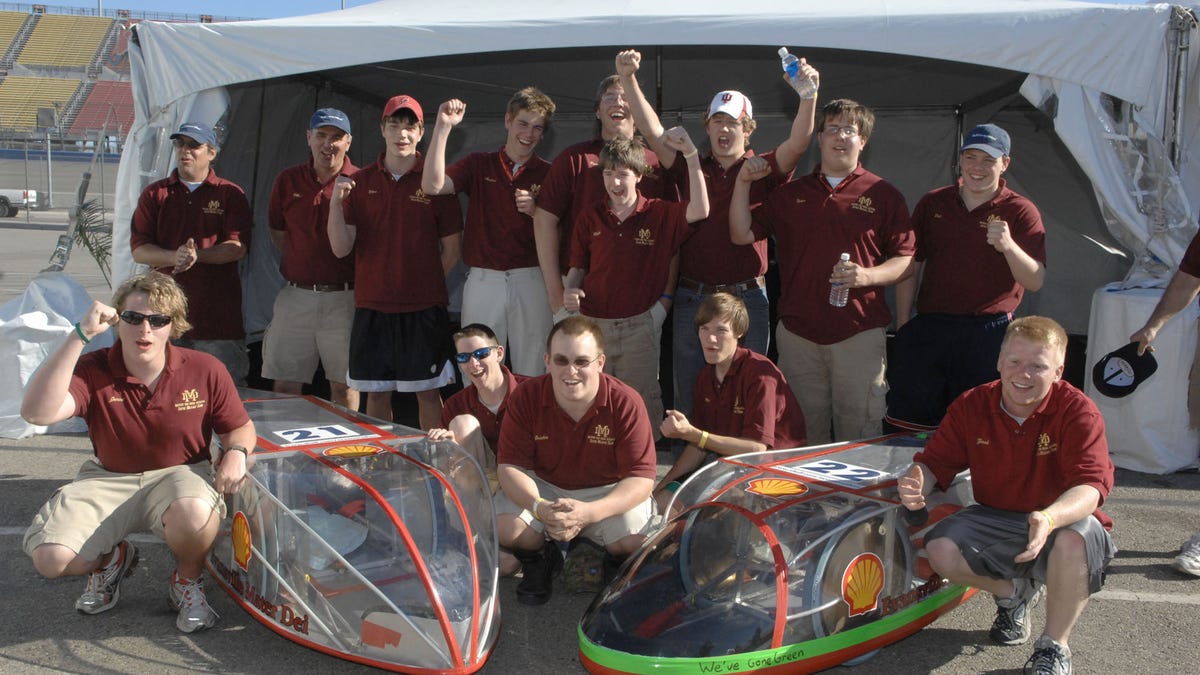At Eco-marathon, teen driving team races to 2,843 mpg
Three vehicles--including two from Mater Dei High School in Indiana--blow away last year's record for traveling very, very far on a gallon of gas.

Correction, 2:50 PM PDT: Due to incorrect information provided by the company, this post misstated the name of one of the fuels used in the Eco-marathon. The entry from Schurr High School ran off liquified petroleum gas (LPG).
The team from Mater Dei High School might be only months (or less) removed from driver's ed, but it pulled off a nifty feat of driving over the weekend. One of its entries in the Shell Eco-marathon Americas won the grand prize for motoring to a record 2,843.4 miles per gallon.
Its other entry proved none too shabby as well, logging 2,383.8 mpg for a strong third-place finish. The second-place vehicle (2,752.3 mpg) was from last year's victor, California State Polytechnic.
All three broke last year's record, set by Cal Poly, of 1,902.7 mpg. The grand prize purse is $10,000.
Mater Dei has been entering the Shell-sponsored event, which took place at the California Speedway in Fontana, Calif., for about five years. How did the Evansville, Ind., team come up with its winning airfoil-meets-teardrop design and beat out its largely collegiate competitors? "It comes from trial and error, seeing what works and what doesn't," an unidentified student and team member told a local newscaster Friday.
Those top three vehicles, like most in the competition (25 out of 33 total), used internal combustion engines. The goal for all entrants was to travel as far as possible using as little fuel as possible. Vehicles--sans driver--couldn't weigh more than 160 kilograms (352 pounds), while drivers had to weigh at least 50 kilograms.
The lone diesel entry, from The College of the Redwoods in Eureka, Calif., achieved 304.5 mpg. The one vehicle to use liquified petroleum gas (LPG), from Schurr High School of Montebello, Calif., hit 163.5 mpg.
Of the four vehicles powered by hydrogen fuel cells, the top finisher was Penn State's HFV Team, 1,668.3 mpg. The best of the two solar-powered entries came from Purdue University, whose Pulsar vehicle reached the equivalent of 2,861.8 mpg. (Solar vehicles weren't eligible for the grand prize.)
On the Fontana racetrack, the challenges included winds that gusted up to 50 miles per hour. Even before the race, though, the team from Universite Laval in Quebec faced its own last-minute challenges--it had to wait two days for its vehicle to clear customs, then had to race through the setup and inspection on the last day of competition. Still, the Laval team finished fifth (1,810.8 mpg), behind another Canadian team, the University of British Columbia (1,864.9).
Rounding out the top 10 in the internal combustion field were Cedarville University (1,151.1 and 1,056.3 mpg for its two Supermileage entries), Grand Rapids Technical High School (754.8 mpg), Colorado School of Mines (679.4 mpg), and Lamar University (572.8 mpg).

